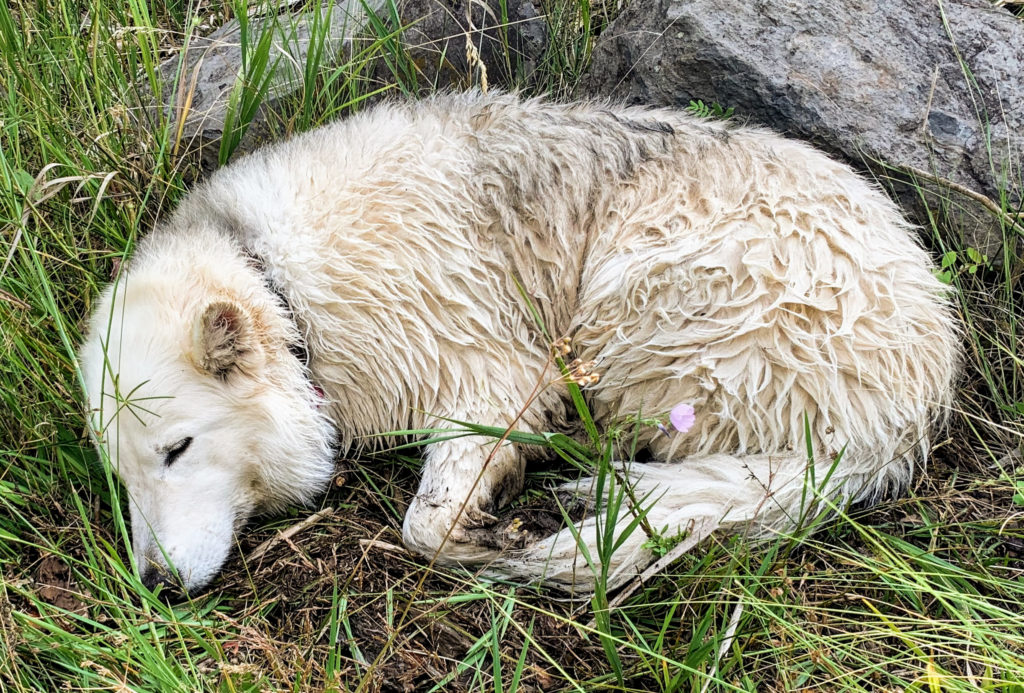In the Shade of the Cottonwood Tree
I was born and raised in the desert. Like most desert plants and animals, I love rain. I live for rain. I live because of rain. Rain heals me, as it heals and seals the cracked surfaces of sunbaked arroyos and limestone canyon walls. It peels back the membranes of seedpods, freeing them to the warm winds and porous soils to replant and grow—shallow rooted and thin bodied. Rain plumps up cactus flesh, sending a moist exhale of rescue breaths down the throats of desiccated, sweat-caked desert dwellers. This collective gasp sweeps across the land. The forced air is said to be the origin of the infamous haboob, the monumental respiration of all living things in the desert when the rain clouds roll in and the infernal sun is finally blotted out. You probably didn’t know this, did you? The power of breath in the desert. In close proximity to sand and the earth’s core, breath is powerful. The air is heavy. Rain rehabilitates the desert world.
As a girl growing up addicted to biannual rain seasons in Tucson, Arizona—summer monsoons and winter maintenance rains—I loved rain so much, I decided to name my first-born human child Rain. Someday. When I had one. Then someday became today and I didn’t have a human child, but instead, I found myself with an immense love for wild things. For displaced wild animals. For the canines that walk the line between domestic and wild, not knowing their sure place. For many reasons I will get to later, I can relate to these animals. The world made us as we are—compatible and cohesive—to gravitate together in a realm of dire solidarity, to band together and survive. To thrive as a pack. And so I began to rescue wolf dogs in danger of euthanasia from animal shelters. My first feral female I, of course, named Rain.
Rain arrived. There was nothing seasonal about her, except that she arrived with the monsoons, and she was weathered. Withered. Scrawny—her fur matted and full of parasites. In spite of this, she was beautiful. A spirit animal from another dimension. A small, white, yellow-eyed, large-toothed wolf. When I took her home from the shelter and bathed her, she howled, she gnawed, she clawed me. She was so malnourished, most of her sinewy fur fell out. She had the beginning stages of an Upper Respiratory Infection (Kennel Cough)—I could tell from the sniffles and runny nose. She fought me, just enough to show will, but she was tired. I lathered her up and scrubbed her down, as she finally submitted, stiff as a board. Fight or flight had passed—Rain was in shock and submission. She was entering the pre-stages of learning to trust and to simply breathe in the desert.
When I finished, she stared blankly at the drain—immobile, hairless, eyes on fire, skinny legs and all. I wrapped a towel around her and lifted her from the elevated tub, her legs sticking straight out, all 35 pounds of her emaciated frame. Her hip and shoulder bones pierced my hands, leaving a lasting impression. I dried her gently with the towel, then set to clipping matted fur from her with scissors and feeding her tiny pieces of dried fish. This, I would soon find, was her element. Soaked to the bone and devouring protein. It would take months before Rain would gaze upon me with her full moon eyes, but she was already beginning to feel me. To lean into me and fight less. And it wasn’t long after that, Rain was racing with me as I reveled in ethology and the genius of all things wild.
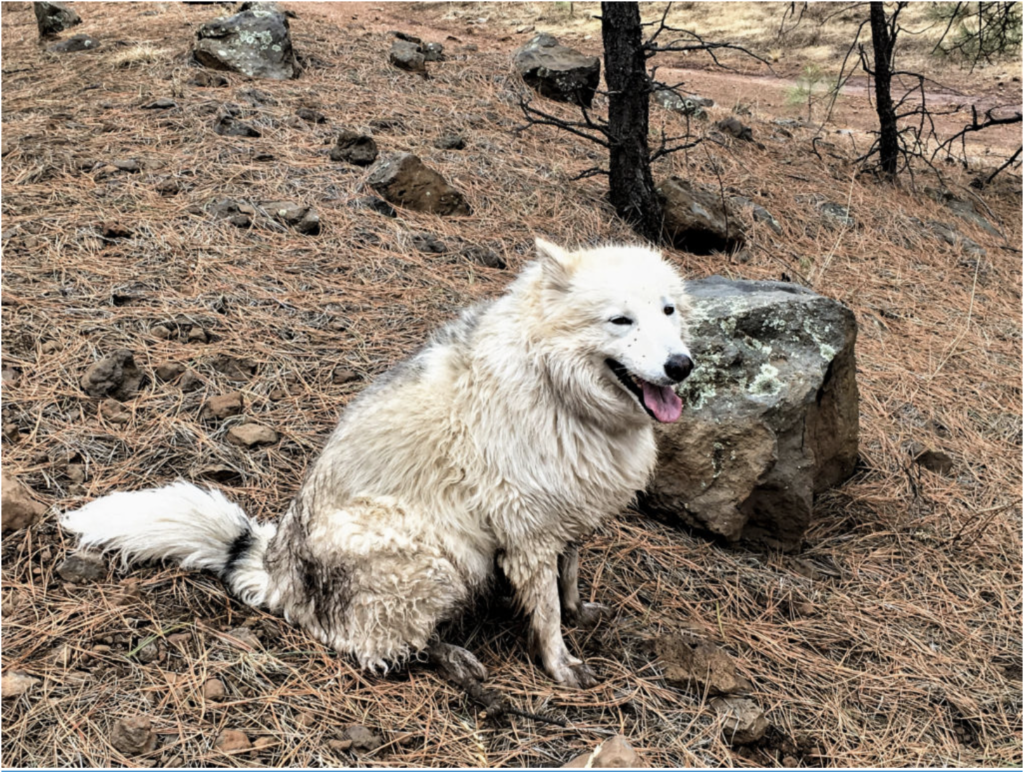
We hit the roads. Rain darted every which way like a minnow, petrified of my footfalls. Each forward step I took, she took two to the side. I finally let her off leash and she began to follow. We also had Shooter, my male Mexican wolf mix, a confident alpha in any pack, leading the way for us. Shooter found me in the back country wilderness of the Tonto National Forest as a young pup. But that story is for another chapter. It was Rain—as Rain needed the rehabbing—that growled and lunged at Shooter, conditioned from her first year of life as a stray in the streets of South Tucson to fight off all competition for resources. And I was her number one resource now. Shooter saw her as damaged and not worthy of his time, snorting into the air with disapproval. So I ran between them. We took to the washes—in between floods—dodging Diamond Backs and chasing rabbits. And the monsoon rains fell. Every afternoon into the evening, like clockwork. It was an El Niño year, and the satiating season for rehabbing Rain had begun.
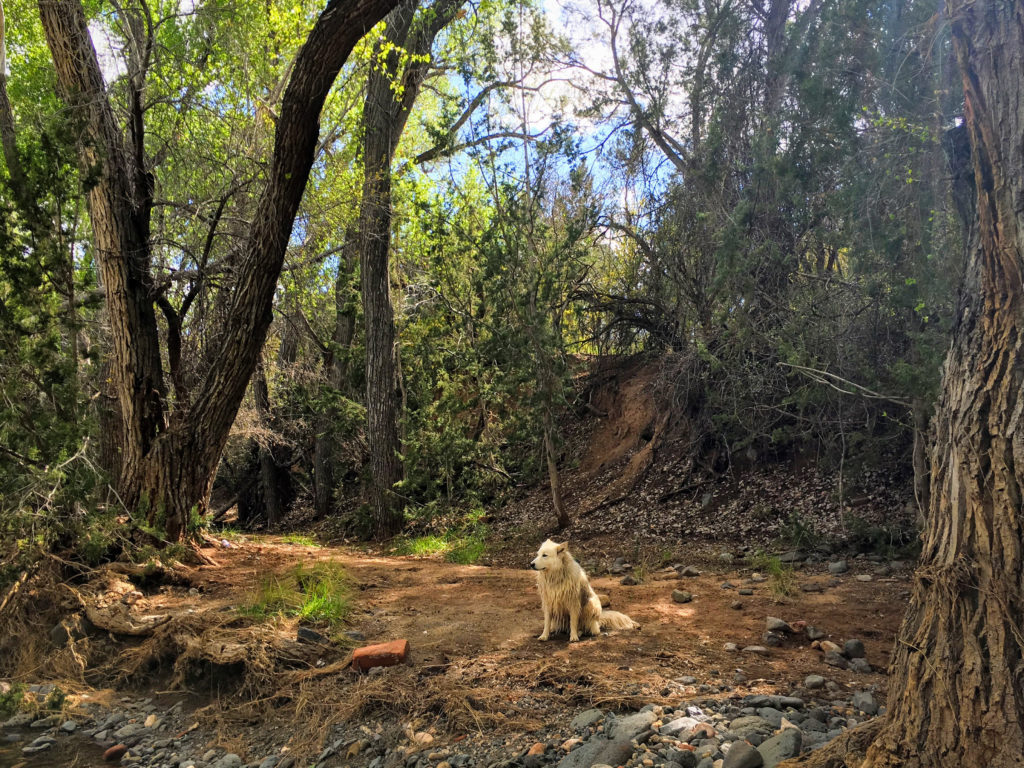
Our adventures rolled in like thunder. It wasn’t an easy time, but miracles did occur daily. And the sheer experience of living in the Sonoran Desert during monsoon season is exciting enough. If you aren’t aware yet, in the summer time, in the Arizona desert, all living creatures seek shade. It’s shade—before the rains begin—that provides relief and rehabilitation from the relentless desert sun. The shade of a tree, the shade of a bush, the shade of a tiny blade of grass—anything to defer the radiant sun that seeks to scorch itself upon the earth, absorbing directly or becoming ambient heat. The permeable flesh of animals—particularly the vulnerable flesh of humans—is the perfect surface to absorb the sun’s rays and burn. The infamous sunburn. Rain and Shooter—my wolf pups—have no problem with this. They never burn, with their numerous layers of fur. Even their vision is protected by dark black rings that encircle wild yellow eyes, cutting back on sun glare and absorption when scanning the landscape for prey or predator. I’m not as perfectly created by nature to triumph in the open range, and the desert reminds me of this. I’m usually lathered in sunscreen, wearing a hat, and I’m always on the watch for confident predators that might land me at the bottom of the food chain. Thank you, large brain, for compensating for my weak, pulpy, defenseless composition and keeping me alive thus far.
In the Rillito River arroyo, there isn’t much shade to be found. There are plants, but they are the usual desert brush, weeds, and small trees like willow, blue palo verde, ironwood, and the highly invasive tamarisk (Saltcedar)—the thirstiest tree in the southwest. But the arroyo is a unique, wild landscape within the urban space of Tucson—a raucous space where rivers sleep, awaiting rain run-off and a majestic awakening and return to the efficacy of desert waterway. Here, in this sleeping river bed, the sand is deep and the sun beats without reprieve. It ebbs and flows in piles and waves—both sand and sun—hardening into a concrete-like mass in the center where most of the vegetation grows. The soil in this arroyo is so loose, so unsettled and exposed that roots run rampant, clinging to one another in anticipation of the next upheaval. The next accumulation of hydrogen and oxygen molecules so rarely combined in this moonscape of a desert-ed land.
Naturally, this arroyo is the perfect unregulated corridor for rehabbing Rain and avoiding the throngs of people that casually jog the paved walkway or ride their road bikes at break-neck speeds along the edge of the river run. A place within the city where the rules of wilderness return, and the rules of humans dance in the distance like a desert mirage. Shooter, my six year-old wolfdog, has determined that the fast-moving people on the running path are reminiscent of deer or elk, and that he must lunge at each human missile that passes us, creating a game of chase in a space where it’s not appreciated. So, the empty river bed is where we go to rehabilitate Rain and run wild as monsoon waters might flow[BLH1] .
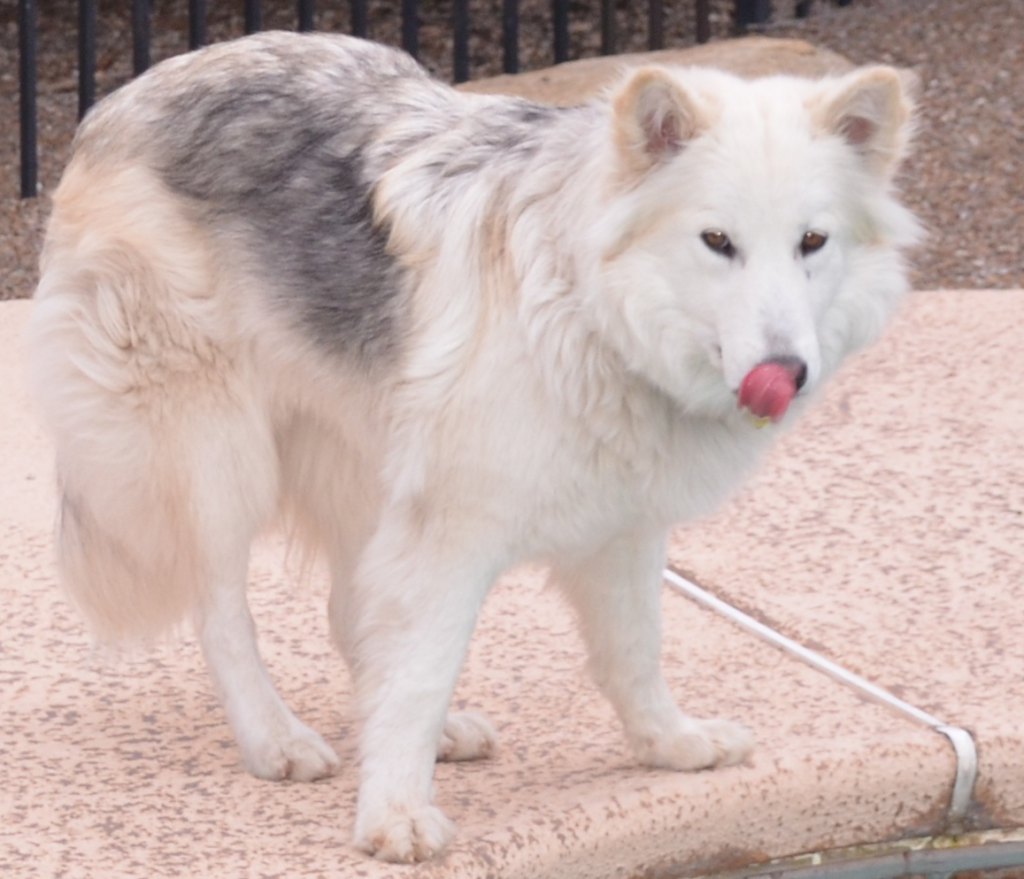
In 2012—an El Niño year with record monsoon rains—I lived in a house that backed to the Rillito River. Next to my house was an open-faced culvert that lead run-off water to the giant anticipating arroyo. Each morning, Rain, Shooter, and I ran like water—like frantically moving and unstable molecules in a liquid state—through the culvert, searching for the lowest, remotest form of land to sink our feet and imaginations into. It’s an interesting metaphor—to let energy build within one’s body each night, restoring cells and flowing as fast as legs can carry, into the harsh landscape of the Rillito. Just like rain. Just like water. Just like anything looking for escape.
We ran early in the morning like flood waters with sharp teeth and punctual cadence, and we ran fast—wolf fur thick and wavy in the warm desert winds. I had a bottle of water in each hand, mostly for my furry friends whose body temperatures were three-to-four degrees warmer than my own. The sun was milder in the mornings, but the air was still heavy and humid, already anticipating cumulus build-up over the local sky islands—the Santa Catalinas, the Santa Ritas, and the Rincons, to name the closest and largest. The wind rushes over these igneous rock formations (at approximately 10,000 ft.), building pressure systems in a time of year when moisture is spinning counter-clockwise out of the Gulf of Mexico, borrowed from the Tropical Cyclone season in the Caribbean and the heated ocean waters close to the equator. This is the monsoon season of the American Southwest.
My wolves ran beside me as we entered the wash. I had a remote shock collar on Shooter, who listened well unless the call of the wild superseded—the call of coyotes known to beckon and lure animals to a playful, pack-oriented death. Like the gingerbread house in Hansel and Gretel or the clown demon in the rain gutters of the horror movie It, the coyotes lured creatures away with their promise of song and dance. Then the pack closed in and tore the creature limb from limb. Nature is not nice. Nature is to survive. I had to step in with the threat of handheld lightning upon encountering coyotes, with their siren-like song that held species survival and murderous intent for anyone less savage than themselves. My wild dogs could probably handle the coyotes, but I wasn’t interested in finding out, only to return with a smaller pack of my own. This would not fare well for our survival, either.
In the lead, Shooter flushed out a rabbit and Rain crept around from the side—as social predators, they began to pursue and hunt as a team. Not truly being hungry, they didn’t catch to kill and eat. They chased and sometimes caught, as a game. And once the animal stopped moving, the game wasn’t fun anymore and they left it. It was clearly all about the chase, as some humans can relate to. On this summer’s day, Rain and Shooter chased a rabbit into the dense, tall growth of weeds and shrubs in the median of the arroyo and disappeared. I didn’t panic. This happened often. I jogged along and looked for an opening or path in the growth, as one usually appeared.
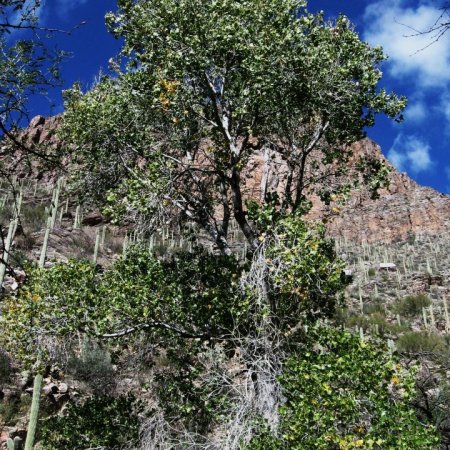
As I mentioned, there are few large trees in the desert. It’s not like a coniferous forest, and most trees are deciduous. In fact, most of the desert landscapes around the world are quite tree-less. The Sonoran Desert (in Southern Arizona) is lush when compared to other deserts. Arizona contains all four North American deserts – the Sonoran, the Mohave, the Chihuahua, and the Great Basin—and it’s the only state that does so. But it’s the Sonoran Desert that allows for certain deciduous, hardwood trees to flourish. The Cottonwood tree is the largest tree in Arizona. So, in a state dominated by all four North American deserts, the largest tree to be found is something special. Something unique. As Cottonwoods are a part of the poplar family—closely related to aspen trees—they require more water than a typical desert area might provide. These Cottonwoods must grow close to perennial, intermittent, or ephemeral waterways.
Every once in a while you might find one of these larger trees in the Rillito—a rare instance in which a Cottonwood or a Sycamore took root and shot straight up into the hot, blue sky. Here and now—there and then—I found the infamous Cottonwood tree—its large, green leaves whispering and fluttering, light bark beginning to grow thick and knobby around the trunk. To find a Cottonwood tree in the middle of an occasional river bed is truly rare, as most of the desert waterways have been invaded by the Tamarisk, which grows like a weed and monopolizes soil nutrients. Cottonwoods are in direct competition with the Tamarisk. This Cottonwood discovery gives one hope for a healthier desert watershed, as groups of these hardwood trees can be seen clustered together from a distance—a bright splash of green leaves and pale bark in a land of mostly blues and browns—and can always lead you to water in the desert. So the Cottonwood signifies a steady water source, which in turn symbolizes survival in the desert.
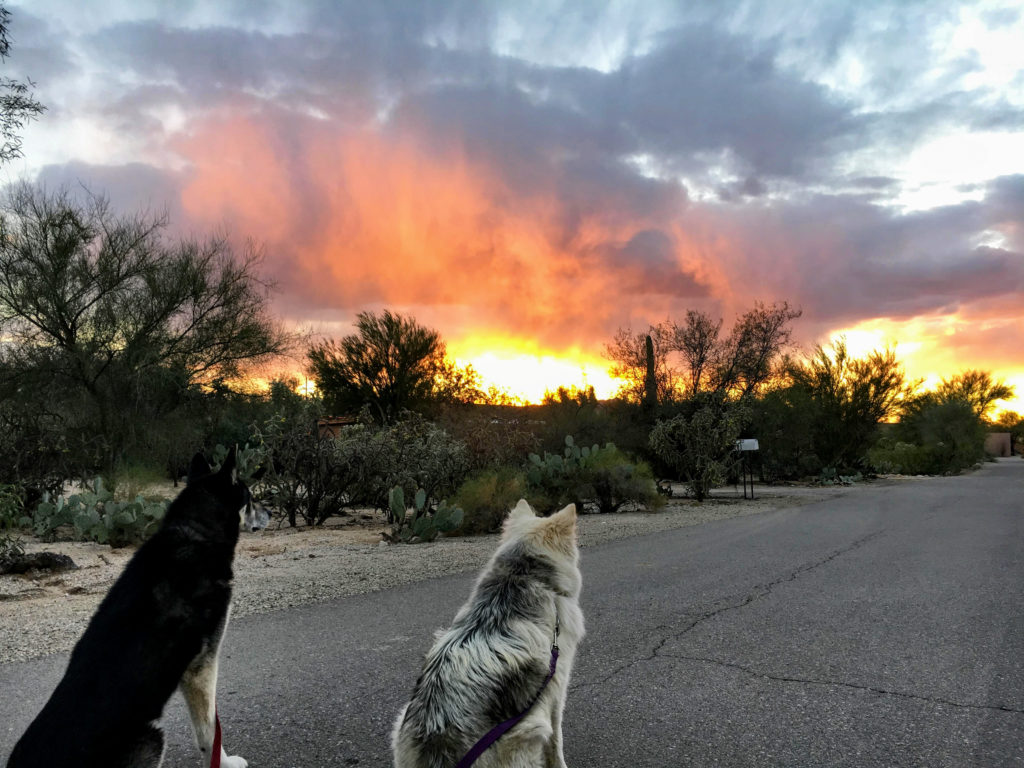
I was looking for my animals, but I was drawn to the Cottonwood, mesmerized by the absolute shadow it cast. The tree wasn’t big, maybe fifteen feet tall, a young version of its future arboreal splendor. As I walked closer, I could see a lean-to beneath the tree—an empty shopping cart tipped on its side and several pieces of plywood propped against the tree. I immediately felt sorry for the tree, for a live tree is not suited to support human construction and utilitarian burden. Then I noticed the dark boots sticking out of the structure, attached to human legs. A man was laying inside. I stopped fast, scanning for the dogs, not wanting to wake or upset a stranger.
As I spun in circles, the wild pups appeared—over their rabbit hunt—and immediately discovered the motionless man. They were on his doorstep in seconds, sniffing and assessing. They seemed calm, so I strained myself to stay calm, too—a very human endeavor and foreign to most of the animal kingdom. They smelled his legs and torso, then entered the wooden tent and started licking his face—probably for the sweat and delicious oils there. I was nervous, but reacting would alarm the intuitive animals, so I stayed still and watched, ready to act or consider interceding if needed. It happened so fast, there wasn’t much left for me to do, anyway. I was a spectator watching human and animal interaction, praying for the best. Willing a benign encounter, or better.
The man stirred. He had a faded blue baseball cap pulled low, a long-sleeved flannel and torn blue jeans. I called in a hushed voice to Shooter and Rain—“Come here, now!”—but they chose this moment for selective hearing, as the new man in the sand was more interesting and aromatically potent than I was. The man’s eyes fluttered open. He slowly lifted his arm and let Shooter lick his hand. Then he began to scratch the large dog’s chest—Shooter’s favorite place to be pet, other than his hind quarters. Rain, afraid of a fluttering shadow, kept her distance, until she couldn’t stand it anymore. She moved in closer and the man scratched behind her ear—her favorite place to be pet, besides her belly. She remained leery, ready to run at the slightest threat, but she let him touch her, which was a sort of desert miracle.
Pretty soon the man was petting the thick, but thinned-out summer coats of both wolfdogs. He sat up, adjusting his cap. I could see his face better. He had a dark beard, and dark brown eyes he kept lowered. He seemed to have an idea of what he was doing.
“Sorry,” I called so he would know I was there and that the animals weren’t alone. I took a few steps closer, but I didn’t want to throw off the balance of animal-human amorous interaction, or send them into guard-the-human-alpha mode.
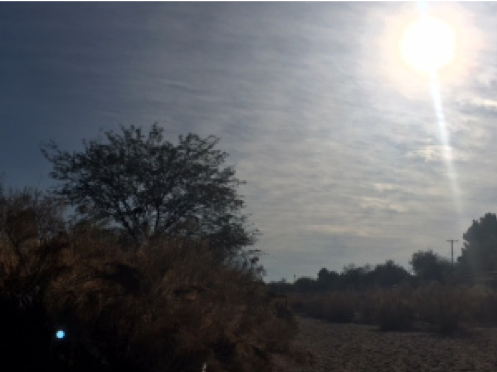
“I thought the coyotes were finally going to finish me off,” he said. He spoke gently, with a noticeable slur. He probably wasn’t sober, but who knows. I couldn’t make out his ethnicity, as the sun had made him a creature of the desert and he was a brownish-red color. He squinted up at me, then the canines. “These here are really big coyotes. Do you run with them?”
I was holding my breath, I realized, so I let it out and smiled. “Yes, they’re my dogs and we run together.”
The man smirked. “These ain’t dogs.”
I laughed nervously. A tinkling sound like rocks falling in a cave.
“Close enough,” I said. “Ninety-nine point eight percent genetically close enough.”
The man ignored my data touting, staying focused on the animals. “I used to have a dog,” he said. “When I used to have a house.”
I didn’t know what to say to that, so I said nothing. But I knew. My roommate in graduate school digressed from genius to homeless in a matter of days, and there was nothing anyone could do. I know it’s rarely a choice. And it’s often mental illness. She was schizophrenic and I didn’t even know. Until she stopped taking her meds. That’s when she unraveled and in a matter of weeks, was running barefoot around the university and downtown with the rest of the local, ephemeral population. The descent from stability was quick, and if she hadn’t had a family that loved her and friends that cared, she would probably still be there, if not dead. I often think of Rachel when I meet homeless people. I think of her when I start to judge someone—how brilliant the human mind can be, how fragile and fleeting our entire existence is. Seeing the world through the eyes of a schizophrenic—danger and death around each jagged, hallucinated corner—made me realize that most homeless people used to have a home. And they probably even used to have a dog. The mentally ill seemed to run in the gap between civilized humanity and the untamed world of wild animals. Like the world of the wolfdog and wild urban landscapes. Like the Rillito River arroyo.
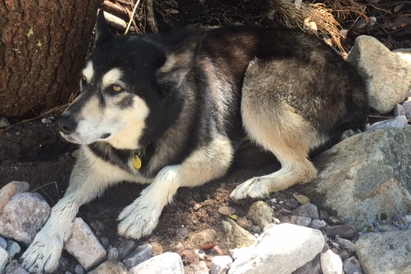
It seemed like I watched for hours as the man pet Shooter and Rain. He stroked them and cooed to them like I wasn’t even there. And incredibly, they stood still and let him. The man was lost in his thoughts, more so with each passing moment. Then, like a gathering desert monsoon, his earth-laden body flooded with emotion and he began to cry. His shoulders shook and tears streamed down his face. Now my Shooter dog is the most sensitive, unruly guardian soul I’ve ever encountered, and human emotion undoes him—the same as thunder. It troubles him to the marrow of his bones. So Shooter whined in response to the man’s tears and licked his face with intensity—an act I’d experienced many times myself. Shooter licked his face with so much concern, the man started to laugh, as the wolfdog’s earnestness and empathy forced a crack in the stone wall of human emotion. A life preserver in a sea of black.
Soon the sunbaked man was roiling with laughter, as Shooter’s antics knocked his hat off, and Rain rolled on her back next to him, offering her belly, catching the playful mood and the need for comic relief. This was the first time I’d seen her vulnerable to anyone but me. The man buried his dark hands in the tangle of Rain’s snow white fur. She wagged her tail and rolled around on her back, smiling upside down with crocodile-like, toothy wit. I’d never seen her do this, but she was enjoying the attention. The man was laugh-crying, so he wiped the moisture from his face, and took deep breaths. As he put his hat back on I could see that it was a faded University of Arizona hat—the red and white “A” now a dark brown. I wondered if he’d been to school, and what sort of events had landed him here, in the bottom of the Rillito River, in the shade of the Cottonwood tree.
With the break in human emotion, Shooter was restless and ready to move on. He was a practical counselor, and not one to dwell in the past. Rain was ready, too. She jumped up and threw herself into Shooter like a tiny wolf wrecking ball, and they were off and running again, kicking up sand in the man’s bed cloths and spinning into the desert wonderland.
The man put his clay hands up in mock protest. He spit sand from his mouth, grinning and shaking his head.
“Sorry about that,” I apologized, feeling self-conscious without the animals.
He slowly wiped sand from his shirt and pants. Then he stared at his palms, face up in his lap for several moments, as if they reminded him of the dogs. He rubbed them together, then, and laced his fingers behind his head. The man was still smiling as he lay back down into the sand. I watched him, wondering if he would respond to me without the animals around.
“Thank you,” he whispered from inside the wooden tent.
I considered thanking him for being so calm. For his willingness to interact with the unknown. For playing a symbiotic role in the rehabbing of Rain. But I didn’t.
“You’re welcome,” was all I said.
I followed in the wake of my ambassadors. As we ran in the raised center of the wash, away from the only Cottonwood tree in the Rillito River for miles, I could already see the cumulus clouds building over the Catalina Mountains. The relative humidity was on the rise and the air temperature would rise with it. Until it began to rain. I watched the fluffy tails of my wolfdogs disappear into tamarisk and willow scrub ahead of me and I couldn’t help but wonder if our new sand man friend would find his way out of the arroyo before the big floods came. I couldn’t help thinking that if he didn’t, at least he would sink beneath the water with a smile on his face.
